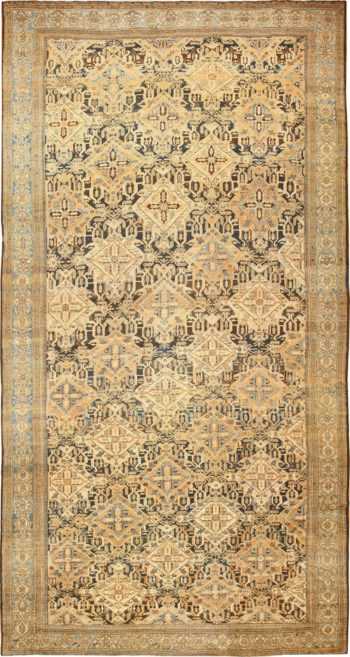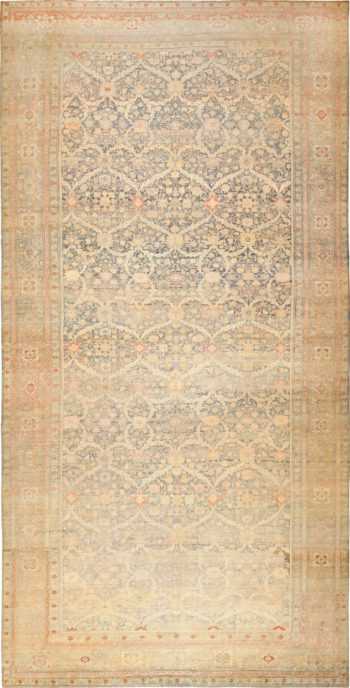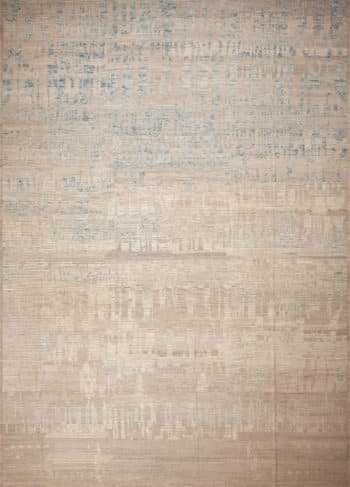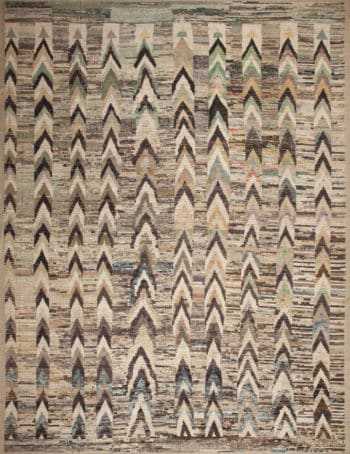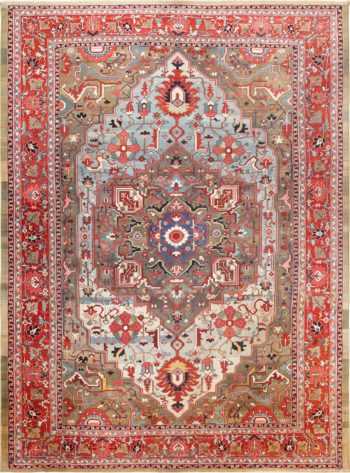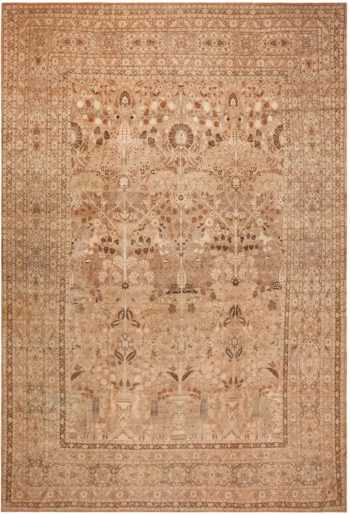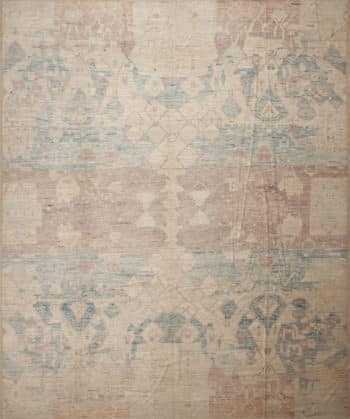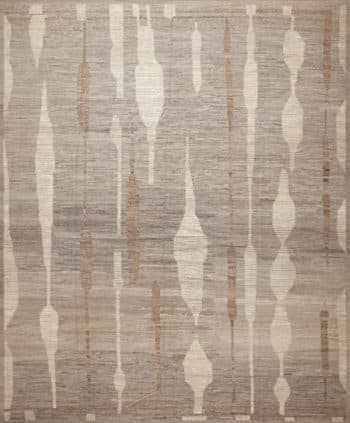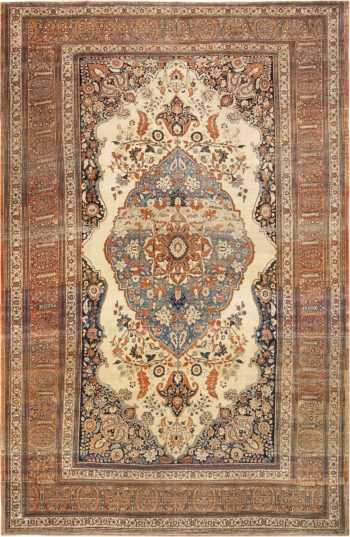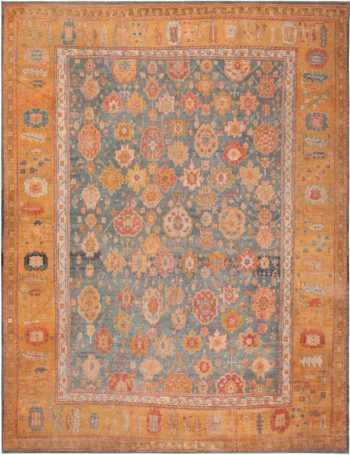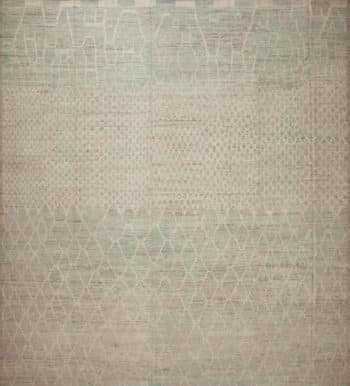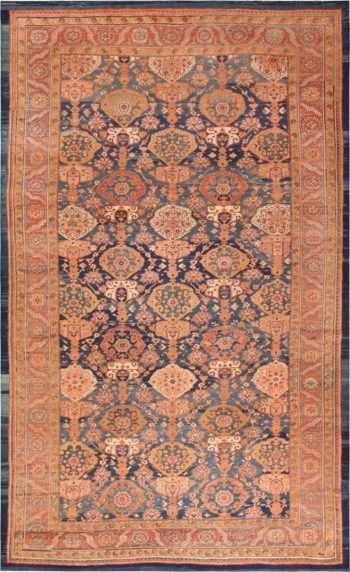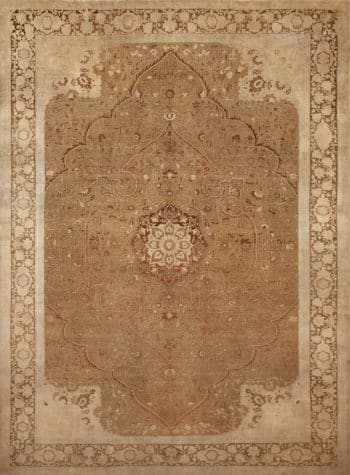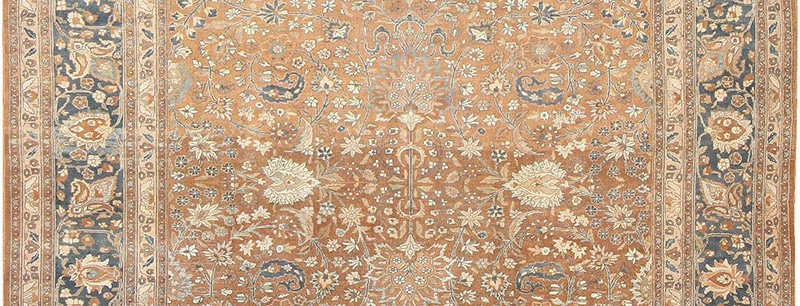Abrash Rugs
See some beautiful abrash rugs from our collection:
Tribal Antique Oversized Persian Bakhtiari Geometric Rug 48042
$96,000.00Size: 15 ft x 30 ft (4.57 m x 9.14 m)Oversized Pale Blue Allover Design Antique Persian Sultanabad Abrash Rug 49076
$88,000.00Size: 13 ft x 25 ft (3.96 m x 7.62 m)Rustic Oversized Decorative Antique Luxurious Persian Sultanabad Rug 71514
$365,000.00Size: 16 ft 10 in x 21 ft 10 in (5.13 m x 6.65 m)Beautiful Fine Luxurious Oversized Antique Large Scale Allover Kerman Persian Rug 48690
$165,000.00Size: 14 ft 8 in x 21 ft (4.47 m x 6.4 m)Beautiful Large Size Allover Design Antique Persian Malayer Abrash Rug 70277
$165,000.00Size: 11 ft 6 in x 20 ft 2 in (3.51 m x 6.15 m)Large Decorative Soft Neutral Light Blue Abrash Tribal Nomadic Modern Rug 11817
Size: 13 ft 8 in x 19 ft 6 in (4.17 m x 5.94 m)Large Size Geometric Chevron Design Modern Area Rug 11868
$15,050.00Size: 13 ft 8 in x 17 ft 7 in (4.17 m x 5.36 m)Large Jewel Tone Antique Persian Heriz Serapi Rug 49993
$94,000.00Size: 12 ft 6 in x 17 ft 6 in (3.81 m x 5.33 m)Rustic Antique Tribal Persian Herati Malayer Abrashed Hallway Runner Rug 48308
$12,500.00Size: 5 ft x 17 ft 3 in (1.52 m x 5.26 m)Rustic Antique Tribal Paisley North West Persian Gallery Size Abrash Rug 72150
$24,500.00Size: 5 ft 4 in x 17 ft (1.63 m x 5.18 m)Beautiful Fine Neutral Decorative Large Antique Persian Tabriz Vase Tree Of Life Design Abrash Rug 71992
$39,000.00Size: 11 ft 7 in x 16 ft 8 in (3.53 m x 5.08 m)Large Soft Neutral Tribal Artistic Contemporary Modern Abrash Rug 11787
$14,350.00Size: 13 ft 10 in x 16 ft 6 in (4.22 m x 5.03 m)Soft Grey Color Large Size Allover Tribal Design Modern Rug 11750
$12,880.00Size: 13 ft x 15 ft 9 in (3.96 m x 4.8 m)Beautiful Large Tribal Room Size Antique Rustic Persian Malayer Rug 48939
$48,000.00Size: 10 ft 7 in x 15 ft 7 in (3.23 m x 4.75 m)Fine Sky Blue Medallion Antique Persian Tabriz Rug 45778
$76,000.00Size: 10 ft x 15 ft 3 in (3.05 m x 4.65 m)Warm Decorative Large Rustic Antique Tribal Abrash Turkish Oushak Rug 71595
$58,500.00Size: 12 ft 6 in x 15 ft 2 in (3.81 m x 4.62 m)Large Modern Neutral Grey With Seafoam Abrash Geometric Tribal Square Rug 11740
$13,440.00Size: 14 ft 2 in x 15 ft (4.32 m x 4.57 m)Beautiful Tribal Antique Decorative Blue Abrash Persian Rustic Bakshaish Rug 71991
$56,000.00Size: 9 ft 10 in x 14 ft 10 in (3 m x 4.52 m)Vintage Abstract Design Moroccan Berber Hallway Runner Rug 47909
$7,600.00Size: 3 ft 9 in x 14 ft 6 in (1.14 m x 4.42 m)Rare Wool And Cotton Soft Color Fine Weave Antique Persian Tabriz Rug 72428
$145,000.00Size: 10 ft 9 in x 14 ft 5 in (3.28 m x 4.39 m)Soft Purple Tribal Antique North West Persian Tribal Abrash Runner Rug 72110
$9,500.00Size: 3 ft 8 in x 14 ft 3 in (1.12 m x 4.34 m)Light Blue Background Creamy White Tribal Pattern Modern Room Size Rug 11651
$9,310.00Size: 10 ft 5 in x 14 ft 2 in (3.17 m x 4.32 m)Abstract Solid Light Ivory Cream And Sky Blue Abrash Modern Room Size Rug 11629
$8,540.00Size: 10 ft 5 in x 13 ft 10 in (3.17 m x 4.22 m)Neutral Earthy Color Tribal Geometric Design Modern Hallway Runner Abrash Rug 11089
Size: 3 ft 2 in x 13 ft 4 in (0.97 m x 4.06 m)
Learn More About Abrash Color Variations in Rugs
Authentic Oriental rugs are handmade with hand-spun yarn rather than being made by a machine. The very nature of handmade rugs gives them a unique pattern that includes variations in color, shades and hues. These color variations are known as Abrash (pronounced ‘Ah-brash’) and are one of the hallmark characteristics of authentic Oriental rugs. Abrash rugs are particularly true of older or and tribal nomadic rugs.
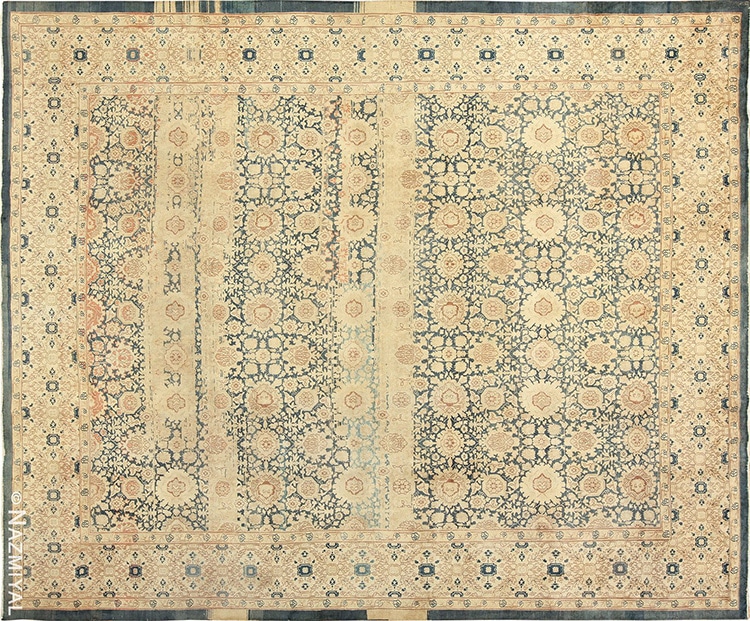
Beautifully Abrashed Oriental Antique Persian Tabriz Rug #49717
When dealing with legitimate abrash coloration, specific areas of solid color will actually have a variety of gradation. These variations will mostly appear as striated horizontal bars or bands, but other shapes or type variations are also possible. In some cases abrash variations may be only the most minute shading difference, while in other cases, they can be quite distinctive and stand out boldly.
Modern contemporary rugs often attempt to duplicate these color variations. Even the manufacturers of new machine-made rugs may try to added them in, but are rarely successful. The colors in machine-made rugs will always be far more consistent and pretty exact. The reason for this is that machines are far more precise than human beings. The human eye, tools and means that hand crafters use to make their wares is often far less precise. This leads to a far more natural and imperfect look than rugs that were created with a machine.
What does the word “Abrash” Mean?
The word “Abrash” means rainbow / spectrum in Farsi. In Oriental rugs, the term is used to describe the visible variations and changes in color of the rug’s front facing pile.
What is the etymology of the word “abrash”?
The term “abrash” has its origins in the world of textiles and carpets, particularly in the context of traditional handmade rugs. The word “abrash” is derived from Persian, an ancient language with a rich history and influence on various cultures.
In Persian / Farsi, “abrash” (آبراش) roughly translates to “variegated” or “speckled.” It refers to a natural variation in color or shade that occurs in hand-dyed materials, such as yarn or thread used in weaving. This variation is often caused by differences in dye batches, variations in dye absorption, or other factors related to the dyeing process. As a result, you might notice subtle shifts in color tone within a single area of a textile or carpet.
In the context of carpets, abrash is often considered a desirable and authentic characteristic, as it adds depth and complexity to the visual appearance of the rug. It can also be used intentionally by weavers to create artistic effects and highlight patterns.
The term “abrash” has been adopted into English to describe this phenomenon, especially in the world of textiles and carpets. It has come to refer to the intentional or unintentional variations in color within a single piece of fabric, carpet, or other woven items.
What causes the abrash to appear in the first place?
For the most part, abrashes are created due to variations in individual batches of dye, or individually dyed batches of yarn. While the colors may look the same at the time that the rug was woven, all human created carpet dye lots vary a little bit. As a result, over the years, each batch will mellow out and fade a little differently. This results in the “abrash affect” – different striated shades of the same base color.
Does Abrash mean that the rug is defect or poorly made?
While some people may look at the abrash coloration and think of them as “imperfections,” in reality, they are not defects at all. Instead, they are the innate characteristic of dye variables that naturally occur when materials are handmade and hand dyed. While some may prefer the more flat and uniform look like those of a machine-made replica, most others will prefer the original and unique distinctions that the hand weaving process brings out. To these individuals, the striated abrash coloration add a distinctive beauty to the rugs and carpets and make them a far more valuable and treasured work of art. In fact, most of the best connoisseurs and rug collectors value the unique beauty that the abrash coloration offer.
Abrashes are so appreciated that many of today’s manufacturers, who are producing some of the highest quality rugs, often put a great deal of time and energy trying to recreate this distinctive look. While they may accomplish this with varying degrees of success, there is still nothing quite as valuable or beautiful as an original handcrafted antique or semi antique rug. In fact, collectors of rugs are often particularly drawn to the most creative and warm abrash found in antique rugs.
If you are considering purchasing an antique or oriental rug for your home, it is important to be aware that the markings that you may at first take to be mistakes, imperfections, repairs or restoration, may actually end up being very markings that often give antique carpets the greatest value.
When buying rugs, inspect them to determine the origin of the color variations. Keep in mind that the striated abrashes may be part of the intended original design, variations in dye lots, different batches of yarn, a natural result of the aging process, or sun fading.
Why do people like rugs with Abrash color variations?
As noted above “Abrash” refers to the subtle variations in color that can be found in handwoven rugs, particularly in the background or field of the rug. These variations occur naturally due to changes in dye lots, different batches of wool, or variations in the tension of the weaving process. While some might view abrash as imperfections, many people actually appreciate and value these color variations for several reasons.
Here are some of the reasons why people buy and love area rugs with Abrash:
- Artistic Authenticity: Abrash is often seen as a sign of the rug’s authenticity and handcrafted nature. It adds character and uniqueness to each rug, distinguishing it from machine-made or mass-produced alternatives.
- Aesthetic Appeal: Many individuals find that abrash contributes to the visual interest and depth of a rug’s design. The variations in color create a sense of movement and texture, making the rug visually dynamic and engaging.
- Antique and Vintage Charm: Abrash is commonly found in antique and vintage rugs due to the historical use of natural dyes and the handwoven process. As a result, abrash can lend a sense of age and history to a rug, adding to its charm and character.
- Warmth and Softness: The subtle shifts in color can create a soft and inviting atmosphere in a room. Abrash can evoke a sense of warmth and comfort, making a space feel more cozy and welcoming.
- Matching with Décor: The variations in color within an abrash rug can make it easier to integrate into various interior design schemes. The slight color shifts can help the rug complement a broader range of furniture and décor choices.
- Connoisseurship and Collectability: Among rug enthusiasts and collectors, the presence of abrash can indicate a higher level of craftsmanship and quality, particularly in handmade and traditionally woven rugs. Collectors often appreciate the unique characteristics that abrash brings to a rug.
- Cultural and Artistic Significance: In some cultures, abrash is seen as a natural and intrinsic part of the rug-weaving process. It reflects the organic nature of handmade art and celebrates the human touch in creating these pieces.
- Conversation Starter: Abrash can spark conversations and discussions about the rug’s origins, materials, and production methods. It adds an element of storytelling and intrigue to the rug.
Overall, the appreciation for rugs with abrash color variations stems from a combination of aesthetic, historical, cultural, and emotional factors. It’s a testament to the rich tapestry of human creativity and craftsmanship that goes into producing these intricate and unique pieces of functional art.
Regardless, abrashes are like fingerprints. No two are alike and each one is uniquely special.

